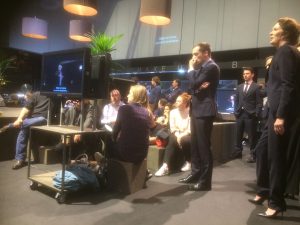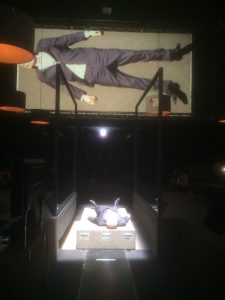
March 20, 2017, by Peter Kirwan
Second view: Roman Tragedies (Toneelgroep Amsterdam) @ The Barbican
I last saw Roman Tragedies eight years ago, when I was a teeny and energetic PhD student for whom theatrical marathons were par for the course. The production was, at the time, one of the biggest influences on my understanding of theatre; it remains on my mental list of my top five Shakespeare productions, and I was even turned into a graphic novel character on the back of my last review of it. Returning to the production after so long (and realising that about half of the company were still playing the same roles) was both nostalgic and energising; a production that felt eerily familiar yet still as dynamic and fresh as the first time I saw it. And as eight years ago, it still prompted one of the fastest spontaneous standing ovations I’ve seen in this country. As I’ve already written a lot about this production in different forums, then, I’ll use this review to point to some particular elements that chimed with me this time.
This time, I spent a lot more time in the auditorium; the advantage of a return visit was less anxiety about trying to find the most exciting places to watch from. While the audience were still invited to come up on stage after 25 minutes and sit among the actors, use the internet, (this is a good point – did we even have smart phones last time? I honestly can’t remember), take photos, and buy food and drink, I kept the same seat for the whole of Coriolanus and Antony and Cleopatra, and relocated to extreme upstage for Julius Caesar. As a result, this time around I found myself paying much more attention to the nuances of individual performances; larger structural elements such as the ‘death chamber’ (which had such an impact on me on my first visit) or the sheer novelty of moving around the stage seemed less important. And yet, these elements still did their important work of serving to give me a sense of liberation. The freedom to move and to check in and out allowed me to actively choose to watch each and every moment; my engagement with the news cycle, with a story, with a human being became an individual bargain struck each time.
Hans Kesting’s Antony struck his own bargain with the news cycle. The section containing the funeral orations for Julius Caesar was a particular highlight, earning its own separate set of applause, and this time I was able to focus on the watchers in the wings, who waited next to my sofa. While Eelco Smits’s Brutus spoke, framed carefully by the state’s apparatus on the video screens, Antony adjusted his tie and fidgeted nervously, staring at a wall. When he went forward he stood silent for a while, then went forward of the podium, beckoning the cameraman to join him at ground level so he could speak directly to it. The reaction of the conspirators, gathering next to me to whisper urgently and angrily at what was happening onstage, was electric. But Antony’s success with the camera, whipping up the unseen masses to civil war, led him to overconfidence. Throughout Antony and Cleopatra he tried to repeat his success in this medium, both parading the gauche, gum-chewing Octavia in front of the camera to formalise their diplomatic marriage, and later standing with Cleopatra, telling the camera that they would fight at sea. Antony’s ease in front of the camera was increasingly disrupted, in the latter instance by Bart Slegers’ Enobarbus screaming at the stupidity of the decision and pushing himself into the way of the camera, only for Antony to keep taking back control of the viewer and repeat calmly ‘We will fight at sea’. The twitches in his face betrayed the fact that, by this point, he was struggling to convince even himself.
 Brutus, Casca & conspirators watch Antony take control of the state media
Brutus, Casca & conspirators watch Antony take control of the state media
While the production was geared effectively towards all parts of the room, I found myself more conscious of Tal Yarden’s phenomenal video design (and Thorsten Alofs’s excellent live camera work) while in the main auditorium. The running news feeds had been updated to include long sequences of Trump’s inauguration, and I particularly noticed some interesting intercutting between Trump and JFK, with a particular focus on JFK’s son running around the White House. But the design of the live feed was even better. Highlights included the moving sequence where Antony and Cleopatra (Chris Nietvelt) sat on sofas separated by some metres, while the screen elided the difference to blur the two sofas into one, making it seem as if their hands were touching. Even more effective was the split screen used when Coriolanus (Gijs Scholten van Aschat) and Aufidius (Slegers again) joined forces. Standing on a downstage platform facing one another, only a metre or so apart, the split screen nevertheless isolated them on the screen, separating them clearly from one another. Yet as they agreed to join and stepped forward to embrace, they met in the space between the two screens; in one medium they embraced, in the other they disappeared completely, merging into one imagined threat.
But what I really want to talk about is the production’s women. Ivo van Hove and Tom Kleijn’s text is an efficient prose translation, evocative (at least in its re-translation into contemporary English) and often very funny; Aufidius calling Coriolanus ‘Mummy’s Boy’ was just one example in which the directness of the translation served to underscore the childishness of aggressive male behaviours and get to the nub of the matter. The cutting came primarily at the expense of smaller roles and male bonding: Menenius was heavily cut; Cinna the Poet and most of the war scenes of Julius Caesar were gone; and the entire Pompey sequence, including that testosterone-fuelled barge scene, was absent. But the roles of the women (both women-as-written and the regendered roles of Cominius, Cassius, Diomedes and Octavius Caesar) were made prominent, and given increasing focus as the production went on. By the time we reached the final third, it felt to me as though the men had become almost an irrelevance in this world.
Hélène Devos (one of the newcomers to the ensemble since I last saw the production) was a revelation as Portia and Octavia. In a ensemble that is increasingly senior, Devos was marked out by her youth, exaggerated in her first appearance in shorts and a sweatshirt emblazoned with a pro-mental health slogan. She was vulnerable and fragile, and was captured for a long time in close-up by the cameras as she lay on her side, speaking to ‘Lucius’ but taking both sides of the conversation. Lucius was a projection for both Portia and her husband; Brutus, too, called to Lucius throughout the production, particularly as he went to his death, but this only underscored his loneliness. Devos returned as Octavia with a devastating naivety. She seemed both thrilled and stunned to be suddenly thrown into the spotlight when Antony agreed to marry her, and threw herself into the long for-the-cameras kiss; yet when she returned in disgrace to her sister, she was shoved and humiliated. In neither of her roles was Devos a victim, but she underscored the human cost of the political disputes.
Marieke Heebink was the other standout for me on this viewing, moving between three very different roles. As a senator in Coriolanus she was austere and brutal, particularly in her snobbish support of Coriolanus against the tribunes. As Cassius she was persuasive and passionate, and surprisingly dignified as she walked to her death. But as Charmian she was a riot. Throughout the Egypt scenes, Charmian kept up a seemingly endless patter of housekeeping, greeting, managing her Queen and generally entertaining everybody. She fired champagne corks into the theatre audience, broke repeatedly into muttered English as she soothed relations between Cleopatra and her underlings, gathered and clinked glasses, and maintained Egypt’s atmosphere of managed informality. The relationship she struck up with Janni Goslinga’s Diomedes – first placating the harangued messenger, then making overtures, then later dancing with her and finally becoming part of a partnership of support for Cleopatra – offered a whole unspoken arc for two characters that extended the world of the play outwards and testified to the osmosis of Cleopatra’s spirit, far better than did the more obvious (though still effective) ploy of having Dolabella kiss Cleopatra passionately as he revealed Caesar’s plans for her.

 Caesar is escorted into the death chamber and captured for posterity.
Caesar is escorted into the death chamber and captured for posterity.
But to single out particular actors is to rather miss the extraordinary work done by a generous and collegiate ensemble. Even when Nietvelt began (entirely rightly) chewing the scenery as Cleopatra, performing an outrageously funny, flawed, human version of the queen who dominated every scene she was in, the entire ensemble worked as a piece, constantly rearranging the stage and creating the overall shared effect of the corridors of power descending into chaos. Everyone had their moments to individually shine, from the beautiful and affecting tears of Coriolanus to Enobarbus crying out on the floor of the Barbican car park (captured remotely via camera feed in one of the true bravura sequences); from Cleopatra’s gut-wrenching howls as Antony died to Brutus’s stony-faced soul-searching before the conspirators arrived; from Nietvelt’s hilariously bumbling Casca to the solemn, unmoving, and terrifying face of Frieda Pittoors as Volumnia. And it wasn’t just the actors who had such a striking effect: the audience member next to me wasn’t the only one petrified by the writhing, real snake that almost stole the show in the final ten minutes, and the aural quality of the production was dominated by the powerful rhythmic percussion of bl!ndman, overwhelming in the cacophonous war sequences.
Roman Tragedies managed the tricky balance of cutting almost all of its roles ruthlessly and contextualising them within a broad sweep of history, yet still privileging the human element amid the technological marvels. The camerawork was no gimmick here; instead, it was a live, dynamic element that allowed the production’s actors to utilise the full range of their abilities, switching from the domineering to the intimate in a heartbeat. Fight scenes (especially the terrifyingly brutal brawl between Coriolanus and the tribunes) gave way to conversations of almost unbearable stillness and quiet; and during Antony’s silence before beginning his oration I could barely even hear the audience breathe. While sitting next to Antony and then Brutus while they listened to the orations of the other, I experienced both the thrill of proximity (I’m next to BRUTUS!) and the thrill of access, as if waiting in the green room at a political conference. This production, more than any other I’ve seen, taps into the modern experience of engaging with the world on one’s own terms, granting (the perception or illusion of?) agency in a way few companies are bold enough to (or, perhaps more fairly, have the resource to). It interrogates the expectations and investment a people put in their leaders; the layers of humanisation added to public figures by the media and its manipulation. And it’s bloody good theatre.
No comments yet, fill out a comment to be the first

Leave a Reply